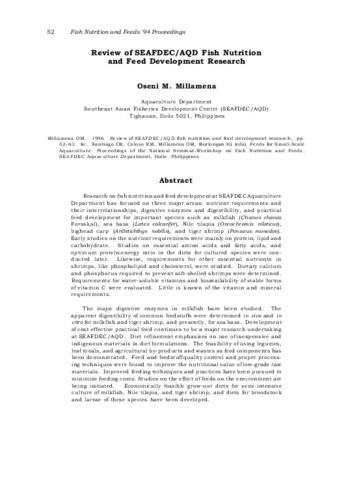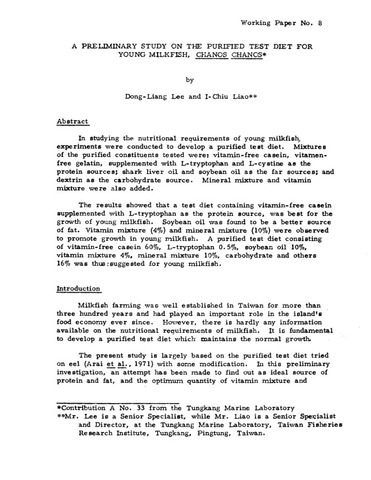Review of SEAFDEC/AQD fish nutrition and feed development research
- Global styles
- MLA
- Vancouver
- Elsevier - Harvard
- APA
- Help
Share
Abstract
Research on fish nutrition and feed development at SEAFDEC Aquaculture Department has focused on three major areas: nutrient requirements and their interrelationships, digestive enzymes and digestibility, and practical feed development for important species such as milkfish (Chanos chanos Forsskal), sea bass (Lates calcarifer), Nile tilapia (Oreochromis niloticus), bighead carp (Aristichthys nobilis), and tiger shrimp (Penaeus monodon). Early studies on the nutrient requirements were mainly on protein, lipid and carbohydrate. Studies on essential amino acids and fatty acids, and optimum proteln:energy ratio in the diets for cultured species were conducted later. Likewise, requirements for other essential nutrients in shrimps, like phospholipid and cholesterol, were studied. Dietary calcium and phosphorus required to prevent soft-shelled shrimps were determined. Requirements for water-soluble vitamins and bioavailability of stable forms of vitamin C were evaluated. Little is known of the vitamin and mineral requirements.The major digestive enzymes in milkfish have been studied. The apparent digestibility of common feedstuffs were determined in vivo and in vitro for milkfish and tiger shrimp, and presently, for sea bass. Development of cost-effective practical feed continues to be a major research undertaking at SEAFDEC/AQD. Diet refinement emphasizes on use of inexpensive and indigenous materials in diet formulations. The feasibility of using legumes, leaf meals, and agricultural by-products and wastes as feed components has been demonstrated. Feed and feedstuff quality control and proper processing techniques were found to improve the nutritional value of low-grade raw materials. Improved feeding techniques and practices have been pursued to minimize feeding costs. Studies on the effect of feeds on the environment are being initiated. Economically feasible grow-out diets for semi-intensive culture of milkfish, Nile tilapia, and tiger shrimp, and diets for broodstock and larvae of these species have been developed.
Suggested Citation
Millamena, O.M. (1996). Review of SEAFDEC/AQD fish nutrition and feed development research. In: C.B. Santiago, R.M. Coloso, O.M. Millamena & I.G. Borlongan (Eds.). Feeds for Small-Scale Aaquaculture. Proceedings of the National Seminar-Workshop on Fish Nutrition and Feeds (pp. 52-63). Tigbauan, Iloilo, Philippines : SEAFDEC Aquaculture Department.
Type
Conference paperCollections
Related items
Showing items related by title, author, creator and subject.
-
Management of feeding aquaculture species
Alava, Veronica R. (Aquaculture Department, Southeast Asian Fisheries Development Center, 2002)This chapter teaches the reader to: differentiate the different feeding strategies in pond culture; learn feeding management methods such as stock sampling and record keeping, calculating daily feed ration, choosing ... -
A preliminary study on the purified test diet for young milkfish, Chanos chanos
Lee, Dong-Liang; Liao, I-Chiu (Aquaculture Department, Southeast Asian Fisheries Development Center, 1976)In studying the nutritional requirements of young milkfish experiments were conducted to develop a purified test diet. Mixtures of the purified constituents tested were: vitamin-free casein, vitamin-free gelatin, supplemented ... -
Potential of feed pea (Pisum sativum) meal as a protein source in practical diets for milkfish (Chanos chanos Forsskal)
Borlongan, Ilda G.; Eusebio, Perla S.; Welsh, Tim (Elsevier, 2003)A 12-week feeding trial was conducted to evaluate the use of feed pea meal as a dietary protein source for juvenile milkfish. Six isonitrogenous (30% crude protein) and isocaloric (16.5 kJ/g) practical diets were formulated. ...







